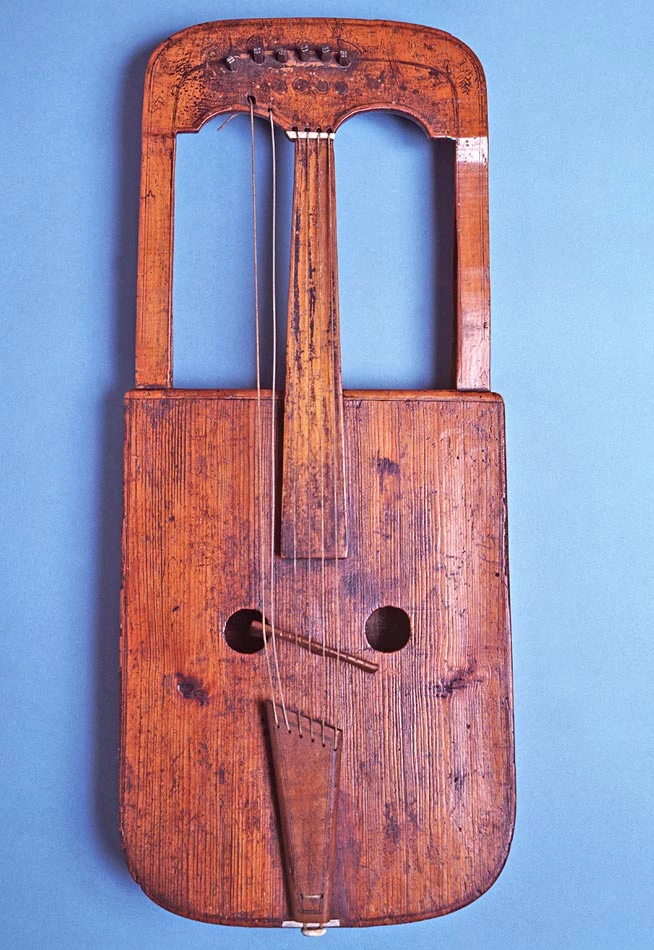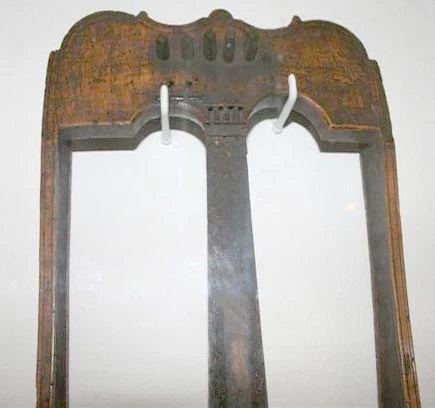A new discovery within an old instrument: was the Welsh crwth unique in possessing two soundboxes?
The National Library of Wales crwth. Image: National Library of Wales
The 18th century crwth housed at St Fagans National Museum of History
Amgueddfa Cymru is fortunate enough to house one of only three surviving authentic Welsh crwths in Britain. Does the discovery of a hidden aperture make the crwth unique amongst bowed instruments by having two soundboxes?
An early stringed instrument first referred to in writing in the 12th century Laws of Hywel Dda (Hywel the Good), the crwth was popular in Wales throughout the Middle Ages, when it was enjoyed in aristocratic circles. The Laws of Hywel Dda mention the crwth, along with the harp and pipes, as instruments of status, played by noblemen and frequently providing musical entertainment.
Crwth competitions were contested in the first recorded eisteddfod, held by Lord Rhys at Cardigan Castle in 1176, while a cywydd poem by Rhys Goch Eryri c.1436, delights in the magicians, acrobats and musicians (crwth players included), who were welcomed into the households of wealthy patrons.
The emergence of the fiddle
The social role of the crwth altered significantly from around 1600 onwards however, when it became more associated with the folk music tradition. The emergence of the fiddle during the 18th century effectively brought crwth playing and crwth making to an end in Wales, closing over a thousand years of practice and development.
When an increase of interest in traditional music eventually took place during the late 20th century, the once common art of constructing a crwth, along with the most appropriate playing methods and performance techniques, had all but become a mystery.
The last remaining crwths
Of the three remaining historical examples in existence, each comprise a six-stringed instrument, oblong in shape and possessing a flat back, sides and soundboard, with the body and soundbox, as well as the main frame, being fashioned from a single piece of wood. A fingerboard divides a rectangular opening at one end while two holes can be seen in the soundboard.
The St Fagans crwth
The crwth in the Museums collection is inscribed 1742 and was made by Richard Evans of Llanfihangel Bachellaeth, Caernarfonshire. It was originally loaned to the museum by Colonel J.C.Wynne Finch of Y Foelas, Caernarfonshire, in 1935; the family of whom retains ownership of the instrument to this day. Although complete there is a line of blocked off tuning pin holes slightly offset from the current set.
The Aberystwyth crwth
The National Library of Wales, Aberystwyth, houses a second crwth, which was donated on the library's opening in 1907 by its principal founder Sir John Williams. This instrument was possibly owned by the Reverend John Jenkins (1770-1829) of Ceri, Montgomeryshire. Although it is complete (with the exception of two missing drone strings), it has undergone restoration/repair at some point to the main framework.
The Warrington crwth
The final example is kept at Warrington Museum and Art Gallery, and although its date is unknown, it bears a likeness to an instrument described and drawn in the 1775 edition of the journal Archaeologia (volume III, plate vii). This crwth was bought in Wales in 1843 by Dr James Kendrick, one of Warrington's first local historians and a noted antiquarian. Kendrick donated the artefact to the town that same year and it became one of the earliest exhibits at the local museum.
The Warrington crwth is less complete than the other two, with missing tailpiece, strings, fingerboard and nut.
The St Fagans crwth under x-ray. The darkened area within the neck clearly shows a tapering void and at its widest point is an aperture concealed beneath the fingerboard.
The x-ray of the National Library crwth displaying the same tapering characteristics as the St Fagans example.
The crwth at Warrington Museum and Art Gallery. © Warrington Museum and Art Gallery
The missing fingerboard on the Warrington crwth allows the tapering void to be seen more clearly. This is visible on the photograph by the lighter bare wood which is bordered by a darker glue-lined impression.
Hidden aperture revealed
Conservation work on the St Fagans crwth uncovered a hidden aperture beneath an overhanging fingerboard. On further inspection this seemed to travel up the full length of the neck. X-rays of the instrument revealed a tapering, very purposeful cavity extending the full length of the fingerboard.
The effect of this void reduces the surface area available for the fingerboard to adhere to the neck. Consequently, it would have been much more difficult to construct than had a solid, flat surface been used - which would have better adhered to the neck upper surface.
What would have been the reason for constructing such an aperture? An increase in the tonal quality of the instrument? The aperture might well have performed in much the same way as the soundbox of an instrument or amplifier to provide a fuller sound to the vibration of the strings.
Unique among bowed instruments?
This second soundbox could possibly make the crwth unique amongst bowed instruments as such a design feature has no comparable legacy in the violin family.
Inspection of the Aberystwyth crwth revealed a similar aperture in the neck. As this surviving example contains different design features to that housed at St Fagans, (and presumably constructed by a different maker), it seems quite plausible that such a void might well have been a consistent characteristic for all crwths.
To confirm this hypothesis, close study of an image from the crwth at Warrington Museum revealed the tapering adhesive lines still visible on each side of the neck, with the bare wood area in the middle, showing the extent of the original aperture. Again, the variations in design suggest a different maker.
Therefore, the inclusion of an aperture in the crwth must have been a standard construction technique that crwth makers employed for the manufacture of the instrument.
The difference this aperture makes to the sound of the instrument could possibly be tested by recording the tonal scale of a replica crwth with a solid fingerboard, and then hollowing out the same instrument and recording the difference.
Ultraviolet discovery
Another aspect worth noting is an ink design that appears on the top surface of the St Fagans crwth's fingerboard, which only became apparent under ultraviolet light examination.
The linear graphic design found under ultraviolet light on the top surface of the fingerboard on the St Fagans crwth.
As the crwth was commonly held against the torso, the player could see down the instrument's neck and a design inked along the neck could possibly have aided the positioning of the fingers along the instrument's length. Interestingly, a vestige of this design also appears on the soundboard of a small harp which is also housed at St Fagans.
Article by: Emyr Davies, Conservator: Furniture, Musical Instruments and Horology, St Fagans National History Museum and Emma Lile, Curator: Music, Sports and Customs, St Fagans National History Museum






Comments - (5)
The image in this article was provided by the National Library of Wales, therefore you would need to contact the National Library of Wales for the image and to clear any possible copyright.
Regards,
Graham Davies
Digital Media
I am putting together a new book of Welsh dialect and the author has asked for an image of a crwth as per the one at the top of this website page.
Would it be possible to let me have a jpeg of this image?
Many thanks
Chris Gilbert